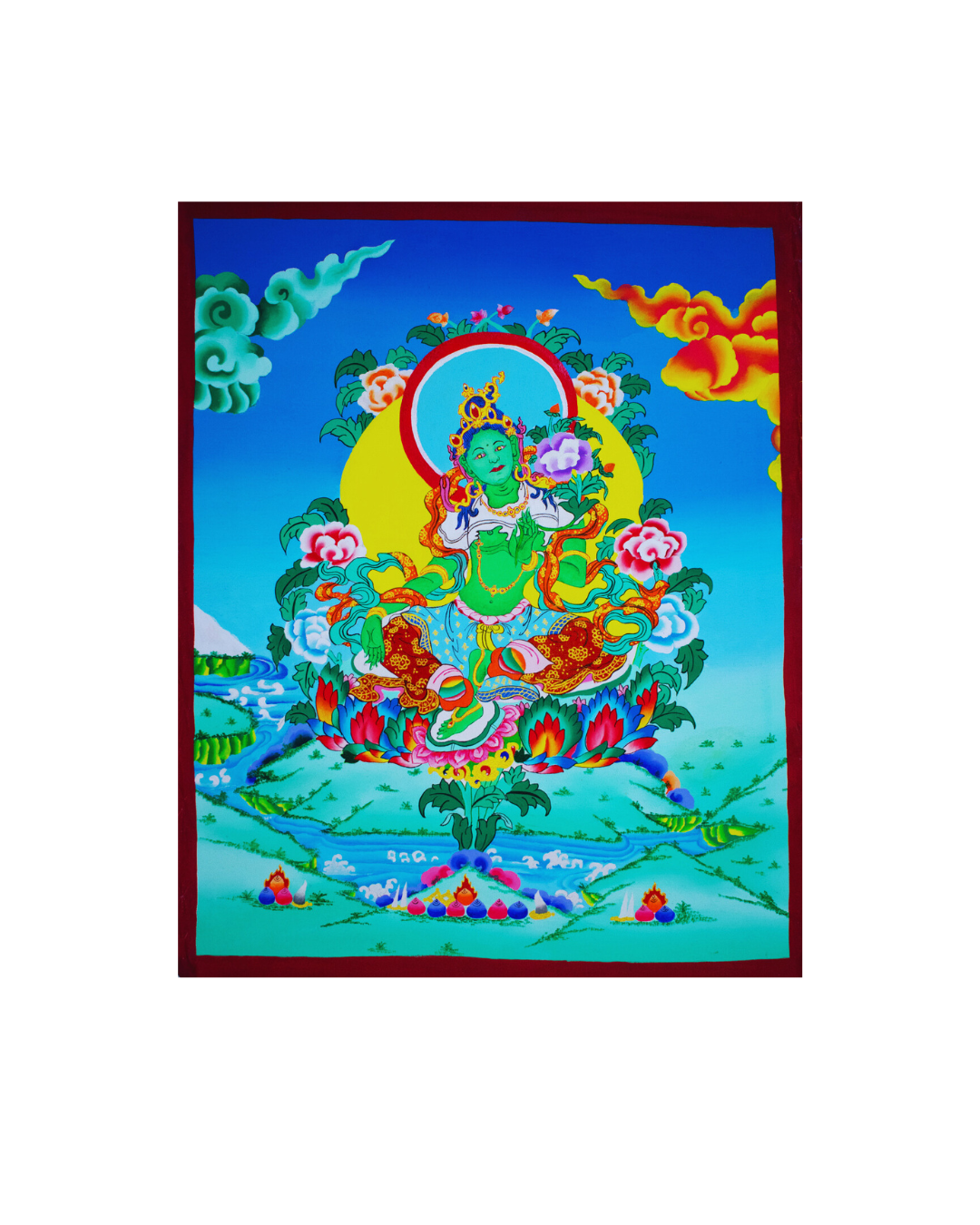Darjeeling Connection
Green Tara, Mother of all Buddhas, Shyamatara (Sanskrit), Jejun Doma (Tibetan) Thangka
Green Tara, Mother of all Buddhas, Shyamatara (Sanskrit), Jejun Doma (Tibetan) Thangka
Couldn't load pickup availability
Green is the universal color of healing, regeneration, and growth, and the Green Tara embodies the healing energy of release from fear and ignorance. The Green Tara embodies the feminine aspect of wisdom expressed through enlightened activity of all the Buddhas, the enlightenment of feminine compassion. Her posture indicates that Tara is always willing and ready to help the needy who pray to her. She holds a lotus that symbolizes all the qualities of Realization within her.
It is said that she arose from the tears of Avalokiteshvara, the bodhisattva of compassion, as he wept in despair because he was unable to fulfill his task to save all beings from suffering. Tara consoled him, and offered to assume the form of a female bodhisattva in order to assist him in his noble endeavors.
Green Tara, also known as Shyamatara in Sanskrit and Jejung Doma in Tibetan, is one of the most popular and revered deities in Tibetan Buddhism. She is considered a compassionate and swift-acting bodhisattva who is ever ready to come to the aid of beings in times of distress. Green Tara is often depicted as a young and beautiful goddess, and she is known as the "Mother of all Buddhas" due to her role in bestowing wisdom and protection.
Thangkas featuring Green Tara is a focal point for meditation and devotion, helping practitioners connect with her compassionate and liberating energy.
Limited Availability: Due to the meticulous craftsmanship involved in creating each thangka, we have limited stock available. Don't miss the opportunity to own this exceptional work of art and spirituality
Here are some key aspects of Green Tara and the common iconography associated with thangkas depicting her:
- Green Color: Green Tara is typically depicted in a vibrant green color, symbolizing her association with activity, compassion, and liberation. Her green hue represents the flourishing and dynamic nature of enlightenment.
- Lotus Seat: Green Tara is often seated on a lotus throne, which symbolizes purity and enlightenment. The lotus is a sacred flower that rises above the muddy waters, signifying transcendence over worldly suffering.
- Mudras (Hand Gestures): Green Tara's right hand is often extended in a gesture known as the "gift-granting" or "wish-fulfilling" mudra, where the thumb and ring finger touch while the other fingers are extended. Her left hand is in a gesture called the "three jewels" mudra, symbolizing the Three Jewels of Buddhism: Buddha, Dharma, and Sangha.
- Seven Eyes: Green Tara is often depicted with seven eyes—three on her face (representing her ability to see the suffering of beings in the past, present, and future) and an eye in each of her hands and feet, symbolizing her vigilant watch over and quick response to the suffering of all sentient beings.
- Vajra and Bell: Green Tara may also hold a vajra (thunderbolt) and a bell, which are common attributes in Tibetan Buddhist iconography. The vajra represents skillful means, while the bell symbolizes wisdom. Together, they signify the union of compassion and wisdom.
- Flowing Hair: Green Tara's long, flowing hair symbolizes her freedom from all bondage and her carefree, spontaneous nature.
- Mantra and Symbols: Thangkas featuring Green Tara may include her mantra, which is "Om Tare Tuttare Ture Svaha." This mantra is chanted for protection and to invoke her compassionate blessings.
- Four Mandalas: In some representations, Green Tara is surrounded by four miniature mandalas in the corners of the thangka. These mandalas represent the four elements—earth, water, fire, and air—and are associated with her role in purifying and harmonizing the elements.
Green Tara is especially revered for her ability to swiftly come to the aid of those who call upon her, and she is often invoked for protection, guidance, and assistance in overcoming obstacles on the spiritual path.
.
Care Instructions
Care Instructions
Materials
Materials
Specially treated cotton canvas; Paints are a mixture of acrylic, gold dust, and stone pigments
Dimensions
Dimensions
20 x 16.75 inch (l x b)
Country of Origin
Country of Origin
India


